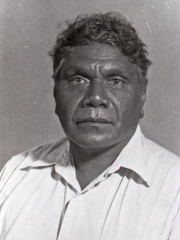
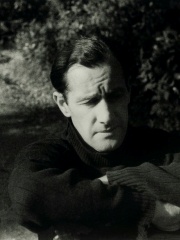
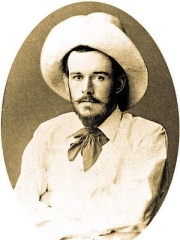
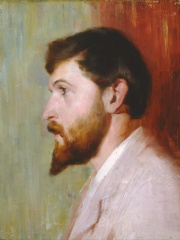
The Most Famous
PAINTERS from Australia
Top 5
The following people are considered by Pantheon to be the most legendary Australian Painters of all time. This list of famous Australian Painters is sorted by HPI (Historical Popularity Index), a metric that aggregates information on a biography’s online popularity.

1. Albert Namatjira (1902 - 1959)
With an HPI of 50.51, Albert Namatjira is the most famous Australian Painter. His biography has been translated into 22 different languages on wikipedia.
Albert Namatjira (pronounced [namacɪra]; born Elea Namatjira; 28 July 1902 – 8 August 1959) was an Arrernte painter from the MacDonnell Ranges in Central Australia, widely considered one of the most notable Australian artists. As a pioneer of contemporary Indigenous Australian art, he was arguably one of the most famous Indigenous Australians of his generation. He was the first Aboriginal artist to receive popularity from a wide Australian audience. A member of the Western Arrernte people, Namatjira was born and raised at the remote Hermannsburg Lutheran Mission, 126 km west-southwest from Alice Springs. He showed interest in art from an early age but it was not until 1934 (aged 32) and under the guidance of Rex Battarbee that he began to paint seriously. Namatjira's richly detailed, Western art-influenced watercolours of the outback departed significantly from the abstract designs and symbols of traditional Aboriginal art, and inspired the Hermannsburg School of painting. He became a household name in Australia and reproductions of his works hung in many homes throughout the nation. In 1956, a portrait of Namatjira by William Dargie became the first of an Aboriginal person to win the Archibald Prize. Namatjira was awarded the Queen's Coronation Medal in 1953, and was honoured with an Australian postage stamp in 1968. Namatjira was the first recorded Northern Territory Aboriginal person to be freed from restrictions that made Aboriginal people wards of the state when he was granted full rights of citizenship in 1957. This gave him the right to vote in national, state and territory elections, gave him freedom of movement and freed him from restrictions on buying alcohol; but, in the Northern Territory, he still had limited land rights. However, Namatjira remained poorly treated by the government; he was sentenced to prison after leaving a bottle of rum on the back seat of his car, which was likely taken and consumed by a man who had then drunkenly beaten and killed his own wife. Public and international outcry intervened in the liability ruling and Namatjira instead served less than two months in a native reserve in Papunya. He continued to live in Papunya with his wife, until he died of heart disease in an Alice Springs hospital in 1959. Described as a "monumental figure" within Australian art, Namatjira is considered one of the most talented Arrernte artists to have lived. As one of the foremost painters of the Hermannsburg movement, he blended indigenous landscapes and Western-style painting techniques to "bring central Australia to life, for thousands who had never seen it for themselves." His legacy lives on through international critical acclaim, the naming of his homeland's electorate after him, and his artistically inclined descendants. They form the artistic and memorial collective the Namatjira project, which includes his Ramsay Prize and Archibald Prize-winning great-grandson Vincent Namatjira.

2. Sidney Nolan (1917 - 1992)
With an HPI of 48.69, Sidney Nolan is the 2nd most famous Australian Painter. His biography has been translated into 28 different languages.
Sir Sidney Robert Nolan (22 April 1917 – 28 November 1992) was one of Australia's leading artists of the 20th century. Working in a wide variety of media, his oeuvre is among the most diverse and prolific in all of modern art. He is best known for his series of paintings on legends from Australian history, most famously Ned Kelly, the bushranger and outlaw. Nolan's stylised depiction of Kelly's armour has become an icon of Australian art.

3. John Russell (1858 - 1930)
With an HPI of 47.70, John Russell is the 3rd most famous Australian Painter. His biography has been translated into 18 different languages.
John Peter Russell (16 June 1858 – 30 April 1930) was an Australian impressionist painter. Born and raised in Sydney, Russell moved to Europe in his late teenage years to attend art school. There, he befriended fellow pupil Vincent van Gogh and, in 1886, painted the first oil portrait of the artist, now held at the Van Gogh Museum. That same year, Russell painted with Claude Monet at Belle Île. Russell moved there soon after with his wife, Marianna Russell, one of sculptor Auguste Rodin's favourite models. Henri Matisse visited Russell at Belle Île in the 1890s, and later credited the Australian with introducing him to impressionist techniques and colour theory. Despite painting prolifically and maintaining close ties with the European avant-garde, Russell rarely exhibited his works and, having received a large inheritance from his father, showed no interest in making money from art. After his wife died in 1907, Russell, grief-stricken, destroyed hundreds of his paintings. He returned to Sydney in old age where he died in relative obscurity. His cousin, Australian artist Thea Proctor, did much to posthumously promote Russell's art, and by the late 20th-century, a number of biographies and exhibitions had helped to restore his reputation as a significant artist. Today his works are held in major galleries in his home country and in Europe, including the Musée d'Orsay and the Musée Rodin in Paris. While in Europe, Russell maintained correspondence with Australian impressionist painter Tom Roberts, updating him on developments in French impressionism. Since he remained in Europe for much of his career and descended into obscurity after his death, Russell became known as Australia's "lost impressionist".

4. Arthur Streeton (1867 - 1943)
With an HPI of 41.62, Arthur Streeton is the 4th most famous Australian Painter. His biography has been translated into 18 different languages.
Sir Arthur Ernest Streeton (8 April 1867 – 1 September 1943) was an Australian landscape painter and a leading member of the Heidelberg School, also known as Australian Impressionism.
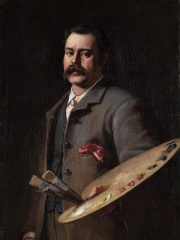
5. Frederick McCubbin (1855 - 1917)
With an HPI of 38.52, Frederick McCubbin is the 5th most famous Australian Painter. His biography has been translated into 15 different languages.
Frederick McCubbin (25 February 1855 – 20 December 1917) was an Australian artist, art teacher and prominent member of the Heidelberg School art movement, also known as Australian impressionism. Born and raised in Melbourne, Victoria, McCubbin studied at the National Gallery of Victoria Art School under a number of artists, notably Eugene von Guerard and later George Folingsby. One of his former classmates, Tom Roberts, returned from art training in Europe in 1885, and that summer they established the Box Hill artists' camp, where they were joined by Arthur Streeton and Charles Conder. These artists formed the nucleus of what became known as the Heidelberg School, a plein air art movement named after Heidelberg, the site of another one of their camps. During this time, he began teaching at the National Gallery school, and later served as president of both the Victorian Artists' Society and the Australian Art Association. Concerned with capturing the national life of Australia, McCubbin produced a number of large landscapes that reflect the melancholic themes then popular in literary accounts of European settlers' interactions with the bush. Several of these works have become icons of Australian art, including Down on His Luck (1889), On the Wallaby Track (1896) and The Pioneer (1904). During his first and only trip to Europe in 1907, McCubbin gained first-hand exposure to works by J. M. W. Turner and the French impressionists, accelerating a shift in his art towards freer, more abstracted brushwork and lighter colours. Works from this late period, although not as well known as his earlier national narratives, are considered by many critics to be his strongest artistically. "When he died", wrote Barry Pearce, "McCubbin was one of the very few Australian painters who found an exalted resolution of vision that progressed with age, so that some of his greatest paintings were made in the last ten years of his life."
People
Pantheon has 5 people classified as Australian painters born between 1855 and 1917. Of these 5, none of them are still alive today. The most famous deceased Australian painters include Albert Namatjira, Sidney Nolan, and John Russell. As of April 2024, 1 new Australian painters have been added to Pantheon including Frederick McCubbin.
Deceased Australian Painters
Go to all RankingsAlbert Namatjira
1902 - 1959
HPI: 50.51
Sidney Nolan
1917 - 1992
HPI: 48.69
John Russell
1858 - 1930
HPI: 47.70
Arthur Streeton
1867 - 1943
HPI: 41.62
Frederick McCubbin
1855 - 1917
HPI: 38.52
Newly Added Australian Painters (2024)
Go to all RankingsOverlapping Lives
Which Painters were alive at the same time? This visualization shows the lifespans of the 5 most globally memorable Painters since 1700.

